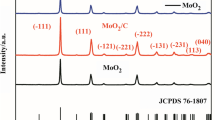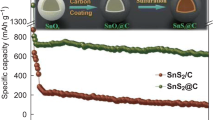Abstract
SnO2@carbon hollow nanosphere composite was prepared via saturating carbonaceous hollow nanospheres (CHN) with the desired metal salt solution by an ultrasonic assisted route followed by heating in air. The ultrasonic treatment is used not only to help obtain more acid sites on the surface of CHN but also to help obtain a homogeneous distribution of SnO2 nanoparticles just anchored on the surface of CHN. The sample exhibits excellent energy storage performance with a specific capacity of 1020 mAh/g after 130 cycles at a current rate of 100 mA/g and very stable cycling performance. The significant improvement may be ascribed to hollow-shell hierarchical structures with a short lithium diffusion path and the better structural stability, as well as the improved reversibility of the conversion reaction. The presented work illustrates a complex lithium storage mechanism in metal oxides and provides a strategy to prepare hierarchical structures with tunable size as a conductive agent free electrode designed for better energy storage properties.




Similar content being viewed by others
References
Ao X, Jiang J, Ruan Y, Li Z, Zhang Y, Sun J, Wang C (2017) Honeycomb-inspired design of ultrafine SnO2@C nanospheres embedded in carbon film as anode materials for high performance lithium- and sodium-ion battery. J Power Sources 359:340–348. https://doi.org/10.1016/j.jpowsour.2017.05.064
Bonaccorso F, Colombo L, Yu G, Stoller M, Tozzini V, Ferrari AC, Ruoff RS, Pellegrini V (2015) Graphene, related two-dimensional crystals, and hybrid systems for energy conversion and storage. Science 347. https://doi.org/10.1126/science.1246501
Chen JS, Lou XW (2013) SnO2-based nanomaterials: synthesis and application in lithium-ion batteries. Small 9:1877–1893. https://doi.org/10.1002/smll.201202601
Chen G, Wang Z, Xia D (2008) One-pot synthesis of carbon nanotube@SnO2−Au coaxial nanocable for lithium-ion batteries with high rate capability. Chem Mater 20:6951–6956. https://doi.org/10.1021/cm801853c
Chen JS, Cheah YL, Chen YT, Jayaprakash N, Madhavi S, Yang YH, Lou XW (2009) SnO2 nanoparticles with controlled carbon nanocoating as high-capacity anode materials for lithium-ion batteries. J Phys Chem C 113:20504–20508. https://doi.org/10.1021/jp908244m
Dahn JR, Zheng T, Liu Y, Xue JS (1995) Mechanisms for lithium insertion in carbonaceous materials. Science 270:590–593. https://doi.org/10.1126/science.270.5236.590
Dong W, Xu J, Wang C, Lu Y, Liu X, Wang X, Yuan X, Wang Z, Lin T, Sui M, Chen IW, Huang F (2017) A robust and conductive black tin oxide nanostructure makes efficient lithium-ion batteries possible. Adv Mater 29:1700136. https://doi.org/10.1002/adma.201700136
Du G, Zhong C, Zhang P, Guo Z, Chen Z, Liu H (2010) Tin dioxide/carbon nanotube composites with high uniform SnO2 loading as anode materials for lithium ion batteries. Electrochim Acta 55:2582–2586. https://doi.org/10.1016/j.electacta.2009.12.031
Idota Y, Kubota T, Matsufuji A, Maekawa Y, Miyasaka T (1997) Tin-based amorphous oxide: a high-capacity lithium-ion-storage. Mater Sci 276:1395–1397. https://doi.org/10.1126/science.276.5317.1395
Jiang F, Wang Q, Du R, Yan X, Zhou Y (2018) Fe7S8 nanoparticles attached carbon networks as anode materials for both lithium and sodium ion batteries. Chem Phys Lett 706:273–279. https://doi.org/10.1016/j.cplett.2018.06.023
Khan I, Ibrahim AAM, Sohail M, Qurashi A (2017) Sonochemical assisted synthesis of RGO/ZnO nanowire arrays for photoelectrochemical water splitting. Ultrason Sonochem 37:669–675. https://doi.org/10.1016/j.ultsonch.2017.02.029
Kim C, Noh M, Choi M, Cho J, Park B (2005) Critical size of a nano SnO2 electrode for Li-secondary battery. Chem Mater 17:3297–3301. https://doi.org/10.1021/cm048003o
Larcher D, Tarascon JM (2015) Towards greener and more sustainable batteries for electrical energy storage. Nat Chem 7:19–29. https://doi.org/10.1038/nchem.2085
Liang J, Wei W, Zhong D, Yang Q, Li L, Guo L (2012) One-step in situ synthesis of SnO2/graphene nanocomposites and its application as an anode material for Li-ion batteries. ACS Appl Mater Interfaces 4:454–459. https://doi.org/10.1021/am201541s
Liang J, Yu X-Y, Zhou H, Wu HB, Ding S, Lou XW (2014) Bowl-like SnO2@carbon hollow particles as an advanced anode material for lithium-ion batteries. Angew Chem Int Ed 53:12803–12807. https://doi.org/10.1002/anie.201407917
Lin T, Chen I-W, Liu F, Yang C, Bi H, Xu F, Huang F (2015) Nitrogen-doped mesoporous carbon of extraordinary capacitance for electrochemical energy storage. Science 350:1508–1513. https://doi.org/10.1126/science.aab3798
Liu J, Li W, Manthiram A (2010) Dense core–shell structured SnO2/C composites as high performance anodes for lithium ion batteries. Chem Commun 46:1437–1439. https://doi.org/10.1039/B918501A
Liu J, Qian D, Feng H, Li J, Jiang J, Peng S, Liu Y (2014a) Designed synthesis of TiO2-modified iron oxides on/among carbon nanotubes as a superior lithium-ion storage material. J Mater Chem A 2:11372–11381. https://doi.org/10.1039/C4TA01596G
Liu M, He S, Chen W (2014b) Co3O4 nanowires supported on 3D N-doped carbon foam as an electrochemical sensing platform for efficient H2O2 detection. Nanoscale 6:11769–11776. https://doi.org/10.1039/C4NR03043E
Liu D et al (2018) Spray-drying-induced assembly of skeleton-structured SnO2/graphene composite spheres as superior anode materials for high-performance lithium-ion batteries. ACS Appl Mater Interfaces 10:2515–2525. https://doi.org/10.1021/acsami.7b15916
Lou XW, Li CM, Archer LA (2009) Designed synthesis of coaxial SnO2@carbon hollow nanospheres for highly reversible lithium storage. Adv Mater 21:2536–2539. https://doi.org/10.1002/adma.200803439
Ma B, Lu B, Luo J, Deng X, Wu Z, Wang X (2018) The hollow mesoporous silicon nanobox dually encapsulated by SnO2/C as anode material of lithium ion battery. Electrochim Acta 288:61–70. https://doi.org/10.1016/j.electacta.2018.08.074
Manocha LM, Bhatt H, Manocha SM (1996) Development of carbon/carbon composites by co-carbonization of phenolic resin and oxidised pan fibers. Carbon 34:841–849. https://doi.org/10.1016/0008-6223(95)00201-4
Ming L, Zhang B, Zhang J-f, Wang X-w, Li H, Wang C-H (2018) SnO2@C/expanded graphite nanosheets as high performance anode materials for lithium ion batteries. J Alloys Compd 752:93–98. https://doi.org/10.1016/j.jallcom.2018.04.008
Nacimiento F, Alcántara R, Nwokeke UG, González JR, Tirado JL (2012) Nanocrystalline CoSn2-carbon composite electrode prepared by using sonochemistry. Ultrason Sonochem 19:352–357. https://doi.org/10.1016/j.ultsonch.2011.06.014
Reddy M, Subba Rao G, Chowdari B (2013) Metal oxides and oxysalts as anode materials for Li ion batteries. Chem Rev 113:5364–5457
Roy P, Srivastava SK (2015) Nanostructured anode materials for lithium ion batteries. J Mater Chem A 3:2454–2484. https://doi.org/10.1039/C4TA04980B
Sui X et al (2018) Organometallic precursor-derived SnO2/Sn-reduced graphene oxide sandwiched nanocomposite anode with superior lithium storage capacity. ACS Appl Mater Interfaces 10:26170–26177. https://doi.org/10.1021/acsami.8b04851
Venhryn BY, Stotsko ZA, Grygorchak II, Bakhmatyuk BP, Mudry SI (2013) The effect of ultrasonic and HNO3 treatment of activated carbon from fruit stones on capacitive and pseudocapacitive energy storage in electrochemical supercapacitors. Ultrason Sonochem 20:1302–1307. https://doi.org/10.1016/j.ultsonch.2013.02.009
Wang Y, Zeng HC, Lee JY (2006) Highly reversible lithium storage in porous SnO2 nanotubes with coaxially grown carbon nanotube overlayers. Adv Mater 18:645–649. https://doi.org/10.1002/adma.200501883
Wang S, Li W-C, Hao G-P, Hao Y, Sun Q, Zhang X-Q, Lu A-H (2011) Temperature-programmed precise control over the sizes of carbon nanospheres based on benzoxazine. Chem J Am Chem Soc 133:15304–15307. https://doi.org/10.1021/ja206333w
Wang D et al (2013) Layer by layer assembly of sandwiched graphene/SnO2 nanorod/carbon nanostructures with ultrahigh lithium ion storage properties. Energy Environ Sci 6:2900–2906. https://doi.org/10.1039/C3EE40829A
Wang Y, Huang ZX, Shi Y, Wong JI, Ding M, Yang HY (2015) Designed hybrid nanostructure with catalytic effect: beyond the theoretical capacity of SnO2 anode material for lithium ion batteries. Sci Rep 5:9164. https://doi.org/10.1038/srep09164https://www.nature.com/articles/srep09164#supplementary-information
Wang H, Jiang G, Tan X, Liao J, Yang X, Yuan R, Chai Y (2018) Simple preparation of SnO2/C nanocomposites for lithium ion battery anode Inorganic. Chemistry. Communications 95:67–72. https://doi.org/10.1016/j.inoche.2018.07.013
Wu D et al (2016) Simple synthesis of TiO2/MnOx composite with enhanced performances as anode materials for Li-ion battery. Electrochim Acta 211:832–841. https://doi.org/10.1016/j.electacta.2016.06.107
Xu W et al (2014) Heterogeneous branched core–shell SnO2–PANI nanorod arrays with mechanical integrity and three dimentional electron transport for lithium batteries. Nano Energy 8:196–204. https://doi.org/10.1016/j.nanoen.2014.06.006
Yan X-b, Tay BK, Yang Y (2006) Dispersing and functionalizing multiwalled carbon nanotubes in TiO2 Sol. J Phys Chem B 110:25844–25849. https://doi.org/10.1021/jp065434g
Yang Z et al (2010) Plum-branch-like carbon nanofibers decorated with SnO2 nanocrystals. Nanoscale 2:1011–1017. https://doi.org/10.1039/C0NR00009D
Yao J, Shen X, Wang B, Liu H, Wang G (2009) In situ chemical synthesis of SnO2–graphene nanocomposite as anode materials for lithium-ion batteries. Electrochem Commun 11:1849–1852. https://doi.org/10.1016/j.elecom.2009.07.035
Zhang B, Wang C, Ru Q, Hu S, Sun D, Song X, Li J (2013) SnO2 nanorods grown on MCMB as the anode material for lithium ion battery. J Alloys Compd 581:1–5. https://doi.org/10.1016/j.jallcom.2013.06.158
Zhang J, Chang L, Wang F, Xie D, Su Q, Du G (2015) Ultrafine SnO2 nanocrystals anchored graphene composites as anode material for lithium-ion batteries. Mater Res Bull 68:120–125. https://doi.org/10.1016/j.materresbull.2015.03.041
Zhang Q et al (2017) Graphene-based carbon coated tin oxide as a lithium ion battery anode material with high performance. J Mater Chem A 5:19136–19142. https://doi.org/10.1039/C7TA05256A
Zhang L et al (2018) Low interface energies tune the electrochemical reversibility of tin oxide composite nanoframes as lithium ion battery anodes. ACS Appl Mater Interfaces. https://doi.org/10.1021/acsami.8b11062
Zhou Y, Wang Q, Zhu X, Jiang F (2018) Three-dimensional SnS decorated carbon nano-networks as anode materials for lithium and sodium ion batteries. Nanomaterials 8:135
Author information
Authors and Affiliations
Corresponding authors
Additional information
Publisher’s note
Springer Nature remains neutral with regard to jurisdictional claims in published maps and institutional affiliations.
Supplementary information
ESM 1
(DOCX 1.22 mb)
Rights and permissions
About this article
Cite this article
Ma, H., Wu, D., Lin, M. et al. Ultrasonic assisted growth of SnO2@carbon hollow nanosphere composites as conductive agent free anode materials for lithium-ion batteries. Ionics 27, 1949–1955 (2021). https://doi.org/10.1007/s11581-021-03983-5
Received:
Accepted:
Published:
Issue Date:
DOI: https://doi.org/10.1007/s11581-021-03983-5




